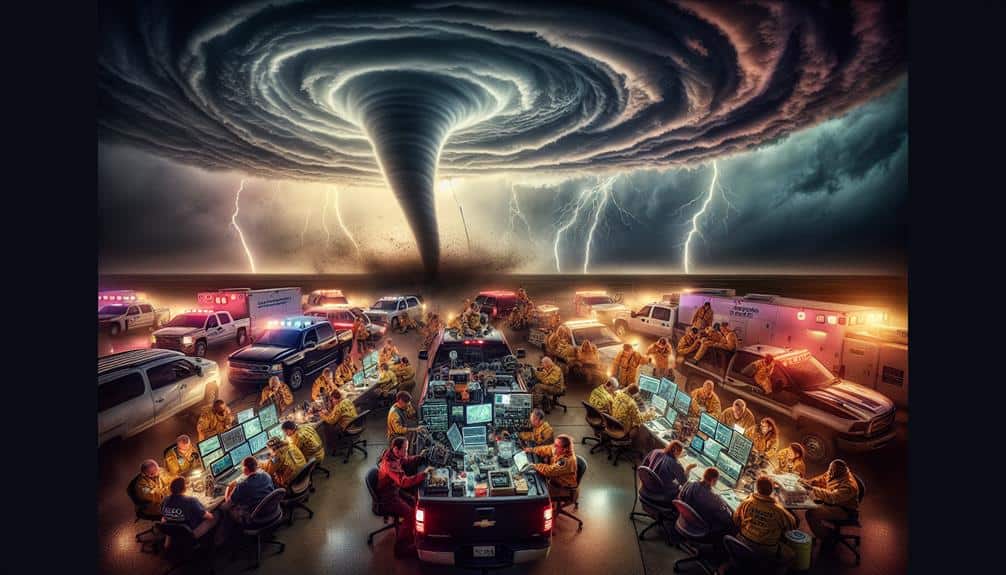We must address the main obstacles in emergency response coordination with a strategic approach. By standardizing communication procedures and leveraging real-time technology, we can guarantee efficient information sharing. Strategically allocating and cross-training personnel boosts our flexibility, while real-time tracking optimizes resource deployment. Using advanced analytics and cloud-based solutions solves data challenges. Effective volunteer recruitment and training enhance our support system. Regular compliance audits and adherence to safety protocols strengthen our response. If we continue to refine these areas, our emergency coordination will significantly improve in efficiency and reliability, revealing more insights for us to explore.
Key Points
- Implement standardized communication procedures and leverage technology for real-time updates.
- Cross-train personnel for versatile roles and effective resource management.
- Utilize advanced analytics and ensure interoperability between data sources for efficient data management.
- Focus on volunteer recruitment, training, and retention strategies to maintain a resilient volunteer force.
Communication Breakdowns
One of the most vital challenges in emergency response is overcoming communication breakdowns. When seconds are of the essence, we can't afford missteps. Improved protocols are necessary to make sure everyone's on the same page.
By implementing clear, standardized procedures, we reduce the risk of misunderstandings and enhance our ability to coordinate effectively.
Technology solutions play a pivotal role in this. Modern communication tools offer real-time updates, location tracking, and instant alerts, making it easier to convey essential information. We need to leverage these technologies to bridge any gaps that traditional methods might leave.
Think about emergency apps that connect directly with response teams or integrated systems that sync data across various platforms. These tools empower us to act swiftly and decisively, ensuring no one's left in the dark.
Strategically, we must invest in continuous training and simulations. Regular drills using these improved protocols and technology solutions can identify weak spots and rectify them before an actual emergency strikes. By staying ahead of potential communication breakdowns, we safeguard our ability to respond efficiently and effectively, ultimately preserving the freedoms we cherish.
Resource Allocation Issues
Let's address the critical resource allocation issues that hinder our emergency response efforts.
We face limited personnel availability, equipment distribution challenges, and budgetary constraints that directly impact our effectiveness.
Limited Personnel Availability
Effective emergency response often hinges on our ability to strategically allocate limited personnel resources. Staffing shortages can severely hamper our efforts, making it critical to optimize every available asset. We must first recognize the constraints we face, then implement robust training solutions to maximize efficiency.
By cross-training our personnel, we equip them with the versatility needed to adapt to various roles during a crisis. This strategic approach not only mitigates the impact of staffing shortages but also enhances our overall readiness.
Moreover, we need to establish a dynamic system for real-time personnel tracking and redeployment. Utilizing technology to monitor availability and skill sets allows us to make informed decisions swiftly. This guarantees that we deploy the right personnel to the right place at the right time, enhancing our response effectiveness.
In addition, fostering partnerships with volunteer organizations and local communities can provide a supplementary workforce during peak demand. By integrating these volunteers into our training programs, we create a well-prepared auxiliary force ready to support our core teams.
Ultimately, overcoming limited personnel availability demands proactive planning, continuous training, and leveraging community resources to guarantee a resilient emergency response framework.
Equipment Distribution Challenges
Guaranteeing the timely distribution of crucial equipment during emergencies demands careful planning and agile execution. We need to address the complex supply chain dynamics that often hinder our efforts. Our ability to swiftly allocate resources hinges on understanding and overcoming these logistical hurdles.
First, we must streamline our supply chain processes. By leveraging technology, we can improve real-time tracking and make sure that each piece of equipment reaches its designated location without unnecessary delays. It's crucial to maintain robust communication channels among all stakeholders, including suppliers, transportation providers, and on-ground responders.
We face significant logistical hurdles, such as unpredictable transportation disruptions and varying regional infrastructure capabilities. To navigate these challenges, we should implement contingency plans that anticipate potential roadblocks and provide alternative solutions. Agile response teams equipped with adaptable strategies can mitigate the impact of these disruptions.
Furthermore, fostering partnerships with local businesses and organizations can enhance our resource distribution network. By tapping into existing local supply chains, we can reduce dependency on distant suppliers and expedite delivery times. We must remain flexible and proactive, making sure that our equipment distribution strategies are both resilient and responsive.
Budgetary Constraints Impact
Financial constraints greatly challenge our ability to allocate resources effectively during emergency responses. With limited funding sources, we often face tough decisions that can impact the timeliness and quality of our actions. These budget restrictions not only strain our operations but also put lives at risk.
To evoke a sense of urgency and drive the point home, consider these critical impacts:
- Delayed Response Times: Without adequate funding, we're unable to procure essential equipment swiftly, which hinders critical response times.
- Inadequate Training: Budget cuts often mean fewer training programs, leaving our teams less prepared to handle real-world emergencies.
- Insufficient Supplies: Limited budgets restrict our ability to stockpile necessary supplies, affecting our readiness and efficiency during disasters.
When funding sources are scarce, we must innovate and prioritize our spending to mitigate these challenges. By strategically reallocating our existing resources and seeking alternative funding sources, such as grants and public-private partnerships, we can strengthen our emergency response capabilities.
We must advocate for increased investment in emergency preparedness to guarantee we've the resources needed to protect our communities effectively. Our freedom to act decisively in crises hinges on overcoming these financial constraints.
Real-time Data Challenges

Managing real-time data challenges is important for the success of emergency response coordination. When we talk about data accuracy, it's not just a luxury; it's a necessity. Accurate data guarantees that our response time is minimized, lives are saved, and resources are efficiently allocated. We can't afford to work with outdated or incorrect information in emergency situations.
One of the primary challenges we face is the sheer volume of data. It's crucial to filter out noise and focus on what matters most. Implementing advanced analytics tools helps us sift through massive datasets quickly and effectively.
Another hurdle is data integration from multiple sources. We need seamless interoperability between systems to create a unified picture of the ongoing situation.
Speed is of the essence, but so is reliability. Real-time data must be both fast and dependable. To achieve this, we must invest in robust communication networks and redundant systems.
Regular training for personnel on data handling and interpretation is also vital. By staying ahead of the curve in technology and training, we can ensure our emergency response remains swift and accurate.
Let's prioritize smart, strategic solutions to navigate these real-time data challenges.
Coordination With Local Authorities
Effective coordination with local authorities is vital for a streamlined and cohesive emergency response. When we work closely with local agencies, we strengthen our ability to respond swiftly and effectively to crises.
Establishing community partnerships and ensuring efficient information sharing are key strategies in achieving this goal.
To foster a successful collaboration, we must focus on the following:
- Build Trust: Trust is the foundation of any effective partnership. By engaging local authorities in regular training exercises and open dialogues, we build mutual respect and understanding.
- Streamline Communication: Clear, direct lines of communication are essential. Establishing standardized protocols for information sharing ensures that everyone's on the same page during an emergency.
- Leverage Mutual Aid: Mutual aid agreements allow us to pool resources and expertise, ensuring we can handle larger incidents that might overwhelm individual capabilities.
Technology Integration Problems

Integrating diverse technologies into a unified emergency response system presents significant challenges. We often face issues with data integration, where different systems don't communicate seamlessly. This lack of interoperability hinders our ability to make real-time decisions, potentially costing lives. We need to guarantee that data flows smoothly between systems, allowing first responders to access critical information instantly.
Software compatibility is another hurdle. Emergency response teams rely on various tools, from dispatch software to GPS tracking systems. When these tools aren't compatible, it creates bottlenecks and inefficiencies. We must prioritize developing or adopting platforms that offer cross-compatibility, ensuring that every piece of software can work in harmony with the others.
Strategically, we should seek open standards and protocols that facilitate easier data sharing and integration. By leveraging cloud-based solutions, we can centralize data storage and access, making it easier for different agencies to collaborate without being hindered by technical limitations.
Ultimately, overcoming these technology integration problems will empower us to respond more effectively, guaranteeing that we maximize our resources and capabilities. It's not just about having the right tools; it's about making sure they work together seamlessly to give us the freedom to act swiftly and decisively.
Volunteer Management
In managing volunteers effectively, we must focus on robust recruitment and training strategies. Employ advanced communication and coordination tools. Implement strong retention and motivation techniques.
By addressing these areas, we can guarantee our volunteer force is skilled, organized, and committed.
Let's explore each component and its impact on our emergency response efforts.
Recruitment and Training Strategies
Recruiting and training volunteers demand a strategic approach to make certain they're prepared for the challenges of emergency response.
First, we need to focus on skill development. Our volunteers come from diverse backgrounds, and it's vital that they receive targeted training to enhance their capabilities. This means offering specialized workshops and hands-on simulations that mirror real-life scenarios.
Next, team building is essential. We can't overstate the importance of fostering a sense of camaraderie and trust among our volunteers. Strong teams not only perform better but also support each other emotionally during high-stress situations. Regular team-building exercises and collaborative missions will help create a cohesive unit.
Lastly, we must guarantee our recruitment strategies are inclusive and far-reaching. We need to tap into various communities to bring in individuals with different perspectives and skills. This diversity strengthens our response efforts and guarantees we can adapt to any situation.
To sum up, our strategic approach must include:
- Skill development to equip volunteers with the necessary abilities.
- Team building to foster unity and resilience.
- Inclusive recruitment to guarantee a diverse and adaptable volunteer base.
Communication and Coordination Tools
Effective communication and coordination tools are essential for managing our volunteer workforce during emergency responses. When crises hit, the swift execution of tasks hinges on our ability to facilitate seamless team collaboration. We need to leverage digital platforms that allow real-time updates and centralized information.
Tools like Slack or Microsoft Teams enable us to maintain continuous dialogue and optimize everyone is on the same page.
Emergency preparedness is another cornerstone. We can't afford to be reactive. By integrating tools like GIS mapping for situational awareness and project management software such as Trello or Asana, we streamline our workflow. These platforms allow volunteers to see their responsibilities, track progress, and adapt to changing conditions instantly.
Additionally, mobile applications designed for emergency communication, like Zello or GroupMe, provide robust channels for rapid coordination. These tools empower us to disseminate information quickly, reducing response times and enhancing our operational effectiveness.
Ultimately, our goal is to create a volunteer management ecosystem that's not just efficient but also resilient. By investing in the right communication and coordination tools, we foster an environment where our volunteers can perform at their best, optimizing we're always prepared for the unexpected.
Retention and Motivation Techniques
To keep our volunteers engaged and committed, we must implement strategic retention and motivation techniques that acknowledge their contributions and foster a sense of community. By doing so, we not only honor their dedication but also create a resilient and cohesive team ready to tackle any emergency.
First, we need to establish motivational programs that reward volunteers for their hard work and dedication. These could range from recognition awards to exclusive training opportunities. Incentives not only show appreciation but also drive continued participation.
Second, let's invest in team bonding initiatives. Activities that promote camaraderie and trust among team members can greatly enhance group dynamics. When volunteers feel connected to their peers, they're more likely to stay committed and perform effectively in high-pressure situations.
Lastly, we must significantly and transparently communicate. Keeping volunteers informed about organizational goals, achievements, and challenges fosters a sense of belonging and purpose. This transparency can be a powerful motivator, making volunteers feel integral to the mission.
Here's what we can do to keep our volunteers engaged:
- Develop robust motivational programs to reward dedication.
- Implement team bonding initiatives to strengthen bonds.
- Maintain transparent communication to cultivate trust and purpose.
Safety Protocols Compliance

Ensuring all team members adhere to established safety protocols is crucial for the success of any emergency response operation. To achieve this, we must prioritize training effectiveness and compliance monitoring.
Effective training programs guarantee that everyone knows the protocols inside and out. We can't afford to overlook this step; it's the backbone of our operational integrity.
We need to implement robust compliance monitoring systems to ensure these protocols are followed rigorously. This means regular audits, real-time reporting, and immediate corrective actions when deviations occur. By keeping a vigilant eye on compliance, we can identify weaknesses and address them before they escalate into bigger issues.
Let's not forget the importance of fostering a culture where safety is everyone's responsibility. When each team member feels accountable, adherence to protocols becomes second nature. This collective responsibility enhances our operational effectiveness and guarantees we're always prepared for the unexpected.
Frequently Asked Questions
How Can We Improve Public Awareness and Education Regarding Emergency Response?
To improve public awareness and education regarding emergency response, we should implement community workshops, launch public campaigns, integrate school training, and provide accessible online resources. These strategies empower individuals, ensuring they're prepared and informed.
What Role Do Community Leaders Play in Emergency Response Coordination?
Ah, community leaders, the unsung heroes of bureaucracy! Their leadership involvement and community engagement are vital. They coordinate communication strategies and resource allocation, ensuring we're all on the same page when disaster strikes. Isn't freedom grand?
How Can International Aid Be Better Integrated Into Local Emergency Response Efforts?
We can integrate international aid better by fostering global partnerships that guarantee local impact. Through effective collaboration and local empowerment, we'll enhance our community's resilience and guarantee aid reaches those who need it most efficiently.
What Training Programs Are Available for Emergency Response Teams to Enhance Their Skills?
We can enhance our emergency response skills through thorough training programs that include simulation exercises and hands-on training. These programs empower us to act swiftly and effectively, ensuring we're prepared for any emergency situation.
How Can Mental Health Support Be Provided to First Responders During and After Emergencies?
'An ounce of prevention is worth a pound of cure. We can provide mental health support through peer support, counseling, and resilience training. Debriefing sessions are essential for ensuring our first responders remain strong during and after emergencies.'


